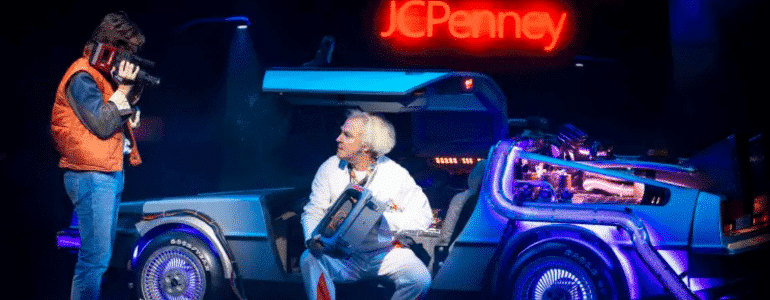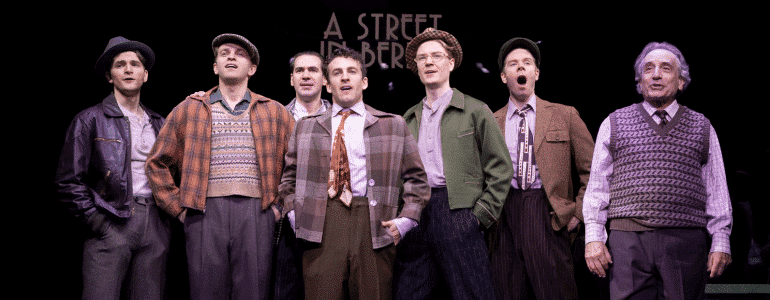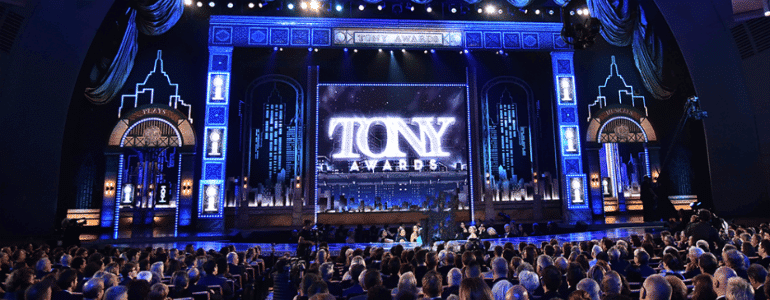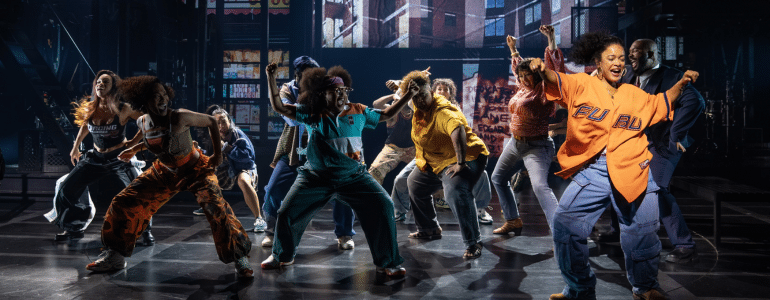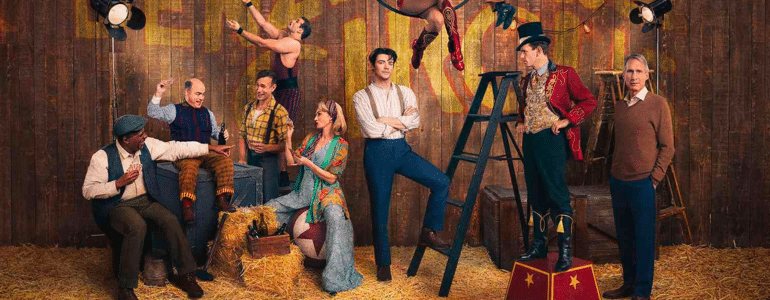Podcast Episode 71 Transcript – John Doyle
Ken: Hello, everybody. This is the Producer’s Perspective Podcast. I am Ken Davenport. We’ve got another captain of the ship on today’s podcast, and this one sails his ship from across the Atlantic. Welcome to the podcast Tony award winner John Doyle. Welcome, John!
John: Hi, nice to see you. Thank you for asking me.
Ken: John has directed over two hundred productions throughout his career. First Broadway production here was the revolutionary Sweeney Todd, the Sweeney heard around the world as I like to call it, won him a Tony for Best Director, went on to direct Company, A Catered Affair, The Visit, which I was a very proud producer on, and this season’s revival of The Color Purple. He was recently named the artistic director of Classic Stage Company here in New York City, getting ready to debut with his first season. Now John, you grew up in Scotland, correct?
John: I did, yes, that’s right.
Ken: So what was your first exposure to theatre there?
John: I really didn’t have any. There was no theatre. There had been a theatre in my hometown and it was closed down, an old Victorian music hall vaudeville house. I did some school play stuff, like everybody does, but I went to theatre school certainly never having seen a professional production. I don’t think I really knew what the theatre was. I had intended to go into the church – I was going to be a minister – and detoured, went and auditioned for two drama schools but I only had to audition for one because I got into it straight away, the Royal Scottish Academy, where fellow alumni are people like Alan Cumming and so on. I was 17 and I think I was still the youngest boy in the school when I graduated, then I came to America on scholarship. I kind of followed my nose.
The family tradition would be like a céilidh tradition, where people sat down and read music together – your uncle would play the violin, your mother would play the piano, or whatever it was. So the whole business that I then, many years later, developed, of people making their own music on stage, is kind of organic, almost indigenous to me. Actually my grandmother took me, now that I think about it, to see a play in London when I was a teenager, at what was called the Whitehall Theatre. There was a man called Brian Rix who ran his own repertory company at the Whitehall Theatre and they did famous classic farces, of the British farce tradition. All I can remember, I remember there being a red curtain and I remember it going up and that’s kind of all I remember, but I do remember it was called Chase Me, Comrade, so that gives you some idea. Funnily enough it was in what became, later on, the Trafalgar Studios, it’s the Whitehall Theatre at the top of Whitehall in London, it became the Trafalgar Studios and that’s where Sweeney Todd happened, so what goes around comes around. But, no, I had no theatre tradition in my family and still don’t – none of them are interested. That’s fine by me but I don’t think any of them really know what I do.
Ken: So you don’t need 37 opening night tickets for any of your shows? Everyone stays home?
John: No, I would be quite happy anyway not to invite anybody to see anything I did. Do you know, I have never sent out a letter saying ‘Please could you come and see this show,’ or anything like that ever? People talk about networking – I’ve never done any of it at all. I don’t know if that’s just that I’m a different generation, but I have never said, “I’m doing this piece of work, could you come?” None of that has ever entered my mind. Isn’t that terrible?
Ken: Well whatever you did seemed to work out.
John: It seemed to sort of work out. Yeah, I suppose that’s true. Things were so much easier when I started in the theatre. I come from a small island and our government paid us to make theatre – the first company that I was artistic director of, I think the Arts Council grant, the equivalent of the National Endowment, I suppose, but it’s a little bit more than that, the grant aid was 75% of our total income. We only had to make 25% of our income at the box office, so that gave you a whole other series of choices. There were 200 repertory theatres, or slightly more, in Great Britain when I started my career so the opportunities were much, much greater. I came over here to go to University of Georgia, to go to school, went back to the UK, got off the airplane early in the morning in Glasgow, and I had a job there, actually. I never thought for a moment that I wouldn’t have a job. I touch the wood that is on your desk – I have never, ever, ever been out of work. I don’t know what that feels like. I have never had to wait tables. But, equally, I would be the first to say to people ‘Don’t do it,’ because I also have seen what rejection does to people; it’s tough. But I have been unbelievably fortunate.
Ken: When you were first drawn to the theatre was it acting or was it directing?
John: I suppose, if I’m truthful, it was acting. I trained, actually, as a drama teacher more than an actor. In those days, in the 70s, there was a big movement in the UK to use theatre as a learning tool in other parts of the curriculum, so you could go into the science department as a drama teacher and use drama techniques as a learning tool to get to what the physicist was trying to say. So it wasn’t about putting on plays, but it was about improvisation and exploration, all of which I still somehow use in what I do.
I was very interested in those days, and I still am, in doing theatre for people who had never made theatre, either people who were in disadvantaged situations or community situations. I have always enjoyed it and continue to do that. But when I was 21, when I started, yeah, I think I wanted to be an actor and I joined a company, a repertory company in Scotland, where I come from, where, you know, you put on a play every three weeks and I understudied all of the men in the season, so I understudied for the Lord and Taylor boy in Barefoot in the Park who goes “Lord and Taylor!” through to Pastor Manders in Ghosts, I covered them all. That was your job as what was called an acting ASM, Assistant Stage Manager, who covered all of the roles. During the season, the woman who ran the theatre said to me, “Would you like to come out for lunch?” and I didn’t think she even knew my name. I said, “Well that’s very kind of you,” so I went out for lunch and she said, “We would like you to direct the play after next,” and I said, “But how do you…” and she said, “We’ve been watching you and we think you could be a director,” so there are angels, and I said, “Oh, that’s kind of you,” because I had absolutely no fear. Now it’s a different story, but in those days, it’s like when you’re young, you go down a ski slope, you don’t think your leg’s going to be the one that breaks. Later on you discover that it is! So I had no fear of that. I got asked to do this play which had in it, in Scotland, a famous actor of the times who is no longer with us. He then asked me to do his next play, which was a one man play at the Edinburgh Festival. Then they asked me to come back and do another play with another famous Scottish actor in it, then I formed my own company. I was 22 and I was running my first company of my own and I thought that was fine, I thought that was what you did. It was as I went on, that I realized that there was more to it than that, but I started a company where four of us bought a truck, a van from the post office, an ex-van, and we bought it for £5.
Ken: £5?
John: Yes, like $8. They were giving them away; it was a wreck.
Ken: Cheaper than gas!
John: Yes! And off we went to the highlands of Scotland, where I come from, to make theatre, and we always got paid every week and within a year we had our own twelve seater minibus given to us by the Arts Council, we had a rehearsal space, etc., but it was a different time, it was a socialist government, they looked at arts in a different way, the whole impasse was about taking theatre to people who had never seen theatre before, it was not commercial, so there were a different set of reasons. Then, in the 1980s – so I did that for five years…six years – and in 1980 I immigrated to England, which really did feel like as much an emigration as coming to live in America because, although I’m British, if you were Scottish it’s a different viewpoint, it’s two different countries glued together. So I became the artistic director of my first building based theatre company when I was 27 or 28.
Ken: Let’s flash forward a little bit to your production of Sweeney Todd, which was obviously historic and the first big thing of yours to come here and create such a splash here. Tell us the story of how it came about and the actors playing the musicians.
John: Well the actors playing the musicians had come before that. I was running a theatre in Liverpool, the Everyman in Liverpool, which was a great space, a very famous space, it’s where people like Willy Russell made all of his plays – Educating Rita happened there for the first time – and it was a lovely, lovely place to work and I had gone there because I had, in previous theatres I had run, been directing musicals and I felt slightly depressed by doing them. I found myself at a place in my life where I thought “I don’t want to do this anymore,” but I couldn’t figure out why. But I did a production of Sweeney Todd as my last production in the theatre that I was running before Liverpool, if that makes any sense, and during that I thought, “I’m not going to do this anymore because I feel I am making a copy of something.” I’m not saying the production wasn’t perfectly good but I was probably, just basically, an artfully recreated, scaled down version of Hal Prince’s original production that happened a couple of blocks away from where we’re talking right now, and I thought “I don’t want to do that.” I knew enough about myself in my early 40s…late 30s, early 40s to know that I didn’t want to be a copier but I didn’t know how to replace that with anything. I was working in Liverpool, I went over to work at the Moscow Art Theatre, which is a very famous theatre in Moscow, before the Berlin wall came down, and I was working there and I watched people work and I thought “Oh, I have to think about different ways of working, I have to address what I’m trying to say in my work, not just how I put a show on but what have I got to say?” At that point I started to learn the word “artist”. I had never thought of that word before; I had always thought the director was a recreator and didn’t really have an original artistic idea but should remount things and make them good – don’t get me wrong, they learn good craft. So I went to Liverpool, did lots of classical work, lots of unusual work for audiences who were, it’s a poor city so it’s a little bit like making theatre in Detroit – that’s a generalization but you understand what I’m saying, a working class city where people couldn’t afford to go to the theatre so one had to be very alive and fresh about how you made theatre in order to get people to come. Four or five years of that and my board of management…directors says to me, “We brought you here because you did musicals and it’s time you did one,” and I said, “I’m not going to do one,” and they said, “Well you have a choice to make – you’d better just get your act together and do a musical.” So I thought “Okay, I’ll show them. I’ll suggest something that we can’t do,” so without really thinking about it, a few weeks later I said, “Okay, I want to do Bernstein’s Candide,” which lots of people have decided they can’t do over time, even though it’s such a wonderful piece, and they said, “Okay, great.” I thought “I’m in a position here where if I don’t do this I’m going to have to leave. I’m putting myself potentially into an untenable position.” I am perfectly good at producing, in a way, so I was in charge of the budget and I looked at the budget and I could afford twelve performers to do Candide but I had no money for an orchestra and, at that time, people like a director called Bob Carlton was making work like Return to the Forbidden Planet with actors that played instruments. I didn’t create that – the Greeks created it, really. Or Buddy was being done – shows where people are playing three chord Jerry Lee Lewis type material, rock and roll shows, and I thought maybe somehow I could find twelve people who could play the score of Candide, which is an audacity if you really stop to think about.
Ken: It’s not Jerry Lee Lewis at all.
John: No, and we did the first week of rehearsal and at the end of the first week I said to the music director “Okay, I think we should spend the Saturday rehearsing the overture,” and I went home that night, I don’t drink anymore, but I went home that night and drank a bottle of scotch. I thought, “This is a disaster and it’s going to have to be taken off,” but I progressed and proceeded with it and it toured all over Great Britain in the end and it was very successful. It was still actors playing and then standing up and acting and then sitting down again. It was very early days, it didn’t have the integration that I developed and worked on as a theatrical language – that really happened over a period of about 15 years, probably. I would do something every year with actors who made music as well, and I started to win prizes and people liked it. And, then I was working a lot at a theatre called The Watermill in Newbury, which is a tiny theatre, it seats 140, beautiful, in the middle of a field in Berkshire, very country but a very beautiful part of the world, and I had done a number of actor/musicians experiments there, Cabaret was a sort of obvious one, Irma la Douce, Into the Woods – actually I did that at York – Fiddler on the Roof I did with ten actor/musicians play as a klezmer band. I shouldn’t have bene doing it, it was basically illegal, but I did it.
Ken: Sheldon Harnick, don’t listen.
John: Don’t listen to this! Then the woman who was running the theatre, who has since died, said to me would I come and do Sweeney Todd that way, the John Doyle way, and I said “No, it’s a terrible idea, it won’t be possible, nobody’s going to be able to play that score, it’s too difficult,” and she said “John, our backs are against the wall, we’re doing really badly at the box office and we need you to come and do this.” I said, “But, Jill, it’s January, nobody’s going to want to show up to do this,” because they paid badly, but because I felt that she needed it to happen, being who I am, I said “Okay, I’ll do it.” So I progressed to doing it, realized I couldn’t really afford a designer so I designed it myself – the first thing I ever designed – when it came to Broadway I was Drama Desk nominated, the world is bizarre! There’s a character in it called Pirelli who was played by a woman in the production – that’s because when I did it at The Watermill I couldn’t get a man to come and do it at that time of year, there was more work for men, I just couldn’t get one and I knew a girl who could play the accordion and I said to her “Do you mind coming to play this role?” and she said, “Yeah, sure, fine, I’ll come over, I’m not working.” Since then, for five years, Pirelli was a woman all over America. People write to me, still, and people have written their PHDs about that production. Everything that happened on that stage was by chance in some way. I don’t want to sound like a charlatan because of course it was decided in the room at the time, don’t get me wrong, I wasn’t just throwing it out there, it was Sondheim for God’s sake, but I expected it only to be done in that four week run at The Watermill. A young man, a young producer, who you remind me of, actually, Adam Kenwright, was there at the first of two previews and said to me, “I’m going to take this to the West End,” and I thought, “Oh, here we go. How many goddamn times have I heard those words?” I said, “Oh yeah, Adam, fine, good luck.” Well, he did, and then they got Mr. Sondheim to come and see it, which was scary, I didn’t know him and I had done things that I shouldn’t have done, because you have to if you’re going to do that piece. At that point I was doing it with nine people – when we came to Broadway we got bigger, we did it with ten – and there were no stars in it, there was nothing, it was a group of mates getting together, and he came and he said, “Oh, it’s something that could only happen in the theatre,” and encouraged me with the little group to come here, and that felt kind of extraordinary and wonderful, truly wonderful.
But, of all the great things that happened with Sweeney I think the finest thing for me, and of course it’s lovely that it won a Tony award, of course, I felt very confused by it but it’s great, was when I got a letter when it was running in London, it came to the stage door and it was from Hal Prince, and I’ve never met Hal Prince, and I’ve treasured and I keep it, and it said, “Dear Mr. Doyle, thank you for doing your production of Sweeney Todd that isn’t a copy of my production,” and it was only the methodology that changed the form of it, I didn’t know that I was doing something that somehow revolutionized something but I do recognize that if that hadn’t happened probably Once wouldn’t have happened and other things with the music being on the stage, in a sense, your production of Spring Awakening had some element of that inside it, because it’s not just about the way you make the music part of the work, it’s the way that you’re saying, as he said, this could only happen in the theatre – the audience has to suspend its disbelief if there is a girl sitting on top of a coffin with a cello between her legs. They have to go somewhere that they wouldn’t not normally go to. So that was a long answer to your point about Sweeney. I shouldn’t say this, really, to the world, but I was happier with Company because it had – and I loved doing Sweeney Todd, don’t get me wrong, but Company, I mean good Lord, I got to work with Patti LuPone, there’s no better place to live, but something about Company‘s simplicity, the ethos of that, you can call me a minimalist, I’ve never called myself that name but that’s how people see who I am, but that had that image, stripped-away. I felt that we made the piece for now and I think that’s what theatre should be doing, it’s not that you can’t set it in its time, but you should be addressing now, and I felt Company did that. At one point it was touring America, Company was on Broadway, and I thought “Jeez, this all happened because I said to that board ‘I’ll show you.’”
Ken: I love it. I have to point out that if you look right over here – sorry, podcast listeners.
John: There you are, Hal Prince.
Ken: That’s a letter from Hal Prince that he wrote to me that I use for inspiration, hanging on the wall.
John: Isn’t that lovely? Not many people write us letters anymore and that’s very beautiful.
Ken: Not at all. So you come here, Sweeney…, Company, Catered, a whole number of things, you’re working here, a sought-after A-list director now – what’s the big difference you saw between directing across the pond and directing here? If you could name one, the biggest difference.
John: The work ethic. I find the work ethic much deeper. I never thought I’d be saying that to the world but I do, it’s the truth, it’s what I feel. I think people, particularly in the musical theatre, there is a true dedication to the form here, it’s not only a way of putting on – well of course it’s hopefully a way of putting on work so that everybody can be employed and make money and all of those things, of course, let’s take that for granted – but there’s a tremendous sense of developing art form and I don’t see that in musical theatre so much in Great Britain. I’ve done major revivals or developments of the work of Stephen Sondheim, John Kander and Jerry Herman – I’m a lucky man, not many people can say that – and they were all remarkable, precious times but – if I could focus on one moment, really, to be in the room with Chita Rivera, Graciela Daniele, Terrence McNally and John Kander watching what you’re doing, and John Kander – at that point 88 years old – going to the piano and restructuring the music, restructuring the form in relation – and chord structures, in relation to what he’s seen you doing on the floor, I think that can only happen in New York City, I really believe that. America should be, I don’t always like musicals but America should be proud of its gift to the world, which is the American musical – It’s the musical! We had Gilbert and Sullivan, don’t get me wrong. We had Noel Coward, we helped the steps, and it’s ironic to me, I used to be naughty and say I wanted to take the Broadway out of Broadway and I didn’t really know what I was talking about, and I kind of did that – I mean I’ve sort of, I think, done that with The Color Purple in a way, but I would do the stripping away anyway. So it’s funny, as a Brit – no, as a Scot – to have taken that journey, but I do think there’s a dedication to the form that sometimes can be a bit crazy, sometimes can be a bit blocky for my taste, but it feels important to people and it’s a very interesting form because it allows you to look into the soul of people, which is what music does, in a way that a play – and I love plays – sometimes plays ask you to work harder – can’t do. So the musical asks you to suspend your disbelief, and I like the suspension of disbelief and I like and am attracted to and believe in the power of the audience’s imagination and in the power of the audience’s imagination you have to have that in a musical because it’s ridiculous if you don’t have that.
Ken: If you could only direct one type of show for the rest of your life – revival of a musical, new musical, revival of a play, classic play or a new play – which one would you choose?
John: New musical. Of course, ideally, it would be written by Stephen Sondheim or John Kander but there are plenty of other good people too, but I’ve worked with people who have changed the form and truly, in the case of somebody like Steve, as Barbara Cook says, changed the face of American musical theatre, and what I love about that is that when you’re with those people in a room making new work, as I did, I felt that Road Show was a new piece, actually, we did so much to it, and certainly The Visit felt like a new piece – I had never seen any of the other versions – those people are artists so they are struggling just like you and I are struggling and are just as afraid as we are, and I love that feeling. I adore doing classical plays and revivals, yes, I get it, because I’ve done three revivals on Broadway now that have been celebrated – I won a Tony for one, one won a Tony and The Color Purple has been successful, people are responding to it in a very fresh way, that’s fantastic, but when I start those pieces I don’t think I’ve reviving anything, you see, I think I’m doing a new piece. I approach it as if it was a new musical, I don’t think “What did so-and-so do with it?” or “I must look up on YouTube what it looked like.” That’s the last thing I do; I don’t work like that at all. I’m not thinking “Because of that experience of Sweeney Todd…’ I’m not thinking ‘I must make a copy of somebody else’s,” I go into the room as if it’s never been done before. I like that, and of course I like the puzzle. You take a piece like The Color Purple which didn’t do badly before, it ran for three years or something, fine, but yes critics will say this one is better, or whatever those things mean. It is a satisfying situation to go into a room with a group of actors and solve, perhaps, some of the things that didn’t get solved the first time around, because musicals are never done, you just open one night, but it’s never finished, how can it be? And so anything I do or have done with The Color Purple couldn’t have been done if Gary Griffin hadn’t done his one the first time around. If I’d been him the first time around, my choices would have been different again.
So I do enjoy the business of reviving, I do love doing new plays and reviving plays. The danger of winning a Tony for a musical is that people think you can only do musicals, particularly when you win one for doing a strange arthouse version of a musical, they think that’s all you can do, but you can only do all that if you’ve done the two or three hundred shows before that – everything leads to everything else. But if I had my dream – I really mean it when I say that when I was in that room with those guys doing The Visit I thought, “This is fine. If I had to stop now, this would be fine because this is really what it’s about.”
Ken: I think you said that to me the first time we met – “Ken, I’m known for Sweeney Todd but I can do lots of other stuff!”
John: I can do Hello, Dolly if you want me to do Hello, Dolly. If you’re in the business – giving names to theatre is so dangerous – but if you are in the business of deconstruction or whatever people decide what I do is, you can only do that responsibly if you know what the alternatives are.
Ken: What’s a more important skill for a director to have today – working with writers or working with actors?
John: I think fundamentally working with actors… let’s take the word “today” out of the question, alright?
Ken: Fine, either way.
John: Let’s just say what’s the director’s most important skill – for me, it’s about the actor. The actor is the channel. I love actors, I love them. They drive me crazy but I love them, I admire them. I’m in the second day of rehearsal right now – I don’t look forward to going to rehearsal but I couldn’t be happier than I am when I’m actually there.
Of course the business nowadays of how the director works for the writer, which has come from directors like Hal, actually, who was one of the first producer/directors who was working very closely with people like Steve and George and so on and so forth, negotiating what they had to write and giving form to what they had to write, what a fantastic skill that is and it’s a blessing when you get to do that, to help a writer to craft new material is a wonderful thing, but some writers can just do that themselves, they don’t always need the director to do that.
I’m so old now that I’m not into the dramaturg thing, I’ve never understood that, I’ve never had one, I don’t really ever want to, I don’t even understand what it is. I think a director should be able to do that, a good director should have some show doctor in them – “You don’t need that chorus, there should be a key change there because that will make people feel differently.” An understanding of what the form is – I think a director has to take responsibility for developing. They may not know that from the get-go; I’m lucky that I’m musical, so I understand what music does if we’re looking at musical theatre, but bottom line I think your job is to explore with the actor how to communicate the text, to make a world in which the actor can feel safe and do their best work.
Ken: Who are the three actors who have driven you the craziest?
John: Oh!
Ken: No, no, no, I’m just kidding.
John: Well I can tell you if you want.
Ken: Yes, tell!
John: Only because it’s craziest in the best possible sense, people like – because I love them – people like Patti or Chita or Harvey, all of those remarkable people that I’ve had the honor to work with. They don’t drive me crazy because of who they are but because of how they question. That’s really great because those are all people who are asking questions all the time – “What does this mean? Where am I going?” Not questions about “Can you help me to look better?” I don’t do that stuff, that doesn’t interest me, but when I mean crazy I mean it in an enlightened, joyous way.
Great actors are naughty in the best way because they’re questioning – it’s their job to question and it’s my job to ask them questions but it’s my job to ask them questions to which I don’t know the answer. If I’m asking questions to which I already know the answer, that’s condescending, whereas if I ask them a question because I don’t know and it’s really important that I can go into a room, which I practice every day in my life, not knowing the answers and still make the room feel safe and still make everybody know that we’ll get the show on in the end.
It’s a little harder once you become your obituary, once you become “Tony Award Winning Director”…it’s a little harder because people come to the room with an expectation, maybe, or a fear, “Oh, we’d better be really good because he’s done that stuff,” or “We saw this of his.” I have to shut all of the voices out of my head that have all that wrapped up in them because my job for myself is to stay in touch with the 21 year old who went down the ski slope and keep going down the ski slope, even though it is more fearful, because it is. I once listened to a broadcast on PBS or something that Peter Hall did, I think it was celebrating that he was 80 or something, I don’t know, and he said, “Now I am afraid to walk into the rehearsal room,” and it was such a relief to me because I thought, “Oh, it isn’t just me,” and I think that is all to do with how much you know you could screw it up and how you could offend or how you could upset or all the things, there’s so many things, how you could get in the way of the story, and the job is not to get in the way of the story.
Ken: So that’s big stars and those big actors – what do you look for when you’re casting an unknown? Who gets your attention when they walk in the room or how do they get your attention? What do you look for?
John: The persons who wear their humanity on their sleeve. I’ve often cast people who I’ve already spoken to. I’m not really interested, I mean it’s helpful if you’re playing Maria in West Side Story if you can sing a top C, of course it’s helpful, so you know, I know there are skills to be checked out, I get it. If it’s a dance show, you have to be able to dance – that’s unlikely to be me that’s directing that.
What always takes American actors, particularly, by surprise is I’ll say, “Sit down, let’s have a conversation,” even before they do their party pieces. “Let’s talk to each other – what do you want to know from me?” and that can be about anything you want to know, like if you want to know why I’m wearing this color of socks, I don’t care what it is, how do we have a conversation? Because I really only want to work with people in all parts of my life who I might want to have dinner with. I’m not saying I would go and have dinner with them all, I don’t want everybody to be my best friend, I’m not talking about that but people who I want to breathe the same air. Life is way too short for anything other than that, just way, way too short, and you can’t actually make good work if the room is not harmonious.
I’m not saying it can’t be edgy, of course it can, but the bottom line is you need to have harmony in the room and you need to be with people you want to be with so that’s what I look for – who do I want to spend the time with? I’m not interested in type, that doesn’t do it for me, who is or is not beautiful does not interest me, I’m interested in vulnerability and fragility and questioning, people who are searching. That’s what I’m interested in.
Ken: Advice for new directors getting started today? You mentioned how it was easier, you said, when you got started. What should a new director do today to become the next John Doyle?
John: Well I suppose the first thing they have to do is try not to be, in any sense, the next John Doyle. I can’t quite believe I’m saying my own name in that context. We are absolutely all learning all the time and that really is the truth. They should not be afraid of their own fear, they should try to, I suppose, look at work and think of what they’re trying to say.
When I worked at the Moscow Art Theatre – I’ve told this story many times – I worked with a designer who I didn’t particularly enjoy being with, I didn’t particularly want to breathe the same air, a Russian designer and myself working together to make two pieces of pretentious theatre that we worked on over there and then happened in Great Britain, and we sat down to have design meetings and he would say “Okay, tell me what you feel,” and I would say, “Oh well, we need a window,” “Why?” “Well, because they look out the window in the play.” “But what are you trying to say?” “Okay, well we need a door because they have to come in and out of the door.” So, in other words, I was problem solving, do you see what I’m saying? I was looking at it going “What are the problems in this? How do I solve them? What do I ask for in order to solve the problem?” He kept saying, “But what are you trying to say?” and I went home from that time in Russia with those words echoing in my mind and I thought, “Okay, John, now you have to make a choice – you either have to go and become a social worker or minister or whatever, and that’s okay, or you have to do what you do, figuring out what you’re trying to say,” and that’s my advice to any young director, is somehow figure out what you’re trying to say.
You don’t have to get it right – we should all have the right to fail. We talked about The Visit – for me, The Visit was one of the great successes of my professional career. If somebody was to write about the producorial package of The Visit in years to come it would be a failure, right? Nobody came. But you can’t use that as your yardstick, right? If it is a failure then it’s glorious and that’s alright. For me, for young directors, put yourself into positions where you can gloriously fail. Hopefully you don’t waste other people’s money in the process, or your own money in the process. Work with actors, find ways, do it in your own back bedroom, whatever it is you need to do. Be me and go off to do that play for my friend who was unwell, who needed somebody to come to her theatre. I didn’t want to go there in January for £300 a week, I didn’t want to do that, but I did and it changed my life, and that man in Russia saying, “What are you trying to say?” absolutely changed my life. So every play I do, everything I do, and I don’t always know at the beginning what I’m trying to say but I try to know by the end. If I don’t that, for me, it doesn’t matter who writes nice things, it doesn’t matter who gives me nice whatever…it doesn’t work.
Ken: What I love about you, and I’m hearing this a lot from directors who are also artistic directors, there’s a real producorial nature to you – you talked about the budgets, doing Candide and how I’m going to make this work – if you could get all of the Broadway producers in a room – he’s chuckling already, this is going to be a good one!
John: Go on.
Ken: If you could get all of us in a room, what’s the one piece of advice you would give to us or that you’d wish they would do as they approach producing theatre on Broadway?
John: Put the story first. Don’t put the result of the story first, put the story first. Decide why you’re telling the story. If you don’t passionately believe whatever, even if it is Chase Me, Comrade, if you don’t passionately believe in that story, stay home, go and mess with somebody else’s life, and if you don’t passionately believe in the story you are messing with the audience’s life, it’s not a good idea.
Also I’m fascinated by – I get it all, I get why the budgets are what they are, I get why it’s so expensive, I wish there were more ways, but I know that many of you are trying to do this and there are more unusual ways of getting people to come to the theatre who don’t come to the theatre. I wish there were ways that the boy from Inverness in Scotland who didn’t know what the theatre was could still go to the theatre and find that out – and I think there are, I think those things exist.
I look at 45th Street, it’s my favorite street in New York City, and you see a name up there on 45th Street and think, “How did that happen?” I think of it as the street of storytellers and our job there is to be there to tell stories and I would love to see what happened if we didn’t put quite so much focus into how we’re going to market that story. Maybe one week we should. There should be two weeks of every year where there was no marketing, no publicity, just nothing. I think people would still come to the theatre because I think it’s so extraordinary that, out of the advent of film, which is the most remarkable art form, people still came to the theatre, people still want to imagine. It’s church on some level – certainly looking at The Color Purple, with what happens in those audiences, it’s better church than most church! I’ve never seen anything quite like it.
I think about trusting the story even more and more and more, and I understand how hard it is – money is to be raised – I completely understand it as a person about to run a not for profit – I hate those words, not for profit, because there’s something slightly derogatory about those words, like what’s profit got to do with it? How do you quantify profit? You see where I’m coming from. I mean I’m a socialist at heart, at heart I believe that we don’t have to tell people what to do, they will come to us. That may be naive, but as an artist you have to remain naive, and I think the other thing for the producer that I might want to say is don’t be afraid of the artist, we’re in this together, we can talk together, we can share each other’s challenges, we don’t have to be afraid of the star, but if people smell fear maybe, then you’ve got chaos on your hands and that’s when the trouble begins. So they don’t have to do that, we are all together. As Patti used to say to me and still says so often, we have to give the theatre back to the actor. I really do believe that, we’ve got to stop the theatre being about technology – let’s not do what the movies do better, let’s do what we do best. It’s a very interesting time this, when on 45th Street in this one season, and I haven’t seen everything, but you take Ivo’s A View From the Bridge and my own The Color Purple, they’re giving theatre back to the actor. His A View From the Bridge didn’t need that set – it was fantastic but it didn’t need that – and The Color Purple, obviously you’ve got those guys and fifteen chairs, that’s all it is really.
Ken: A hell of a designer of The Color Purple.
John: Well bless your heart, that’s another audacity but there we go.
Ken: Alright, my last question, my Genie Question – I want you to imagine the genie from Aladdin comes to see you and says, “John Doyle, I want to thank you for everything you’ve done for Broadway – for taking the Broadway out of Broadway and starting the revolution, because I think you’re so right, your productions have been so inspiring to me and I don’t think the Once‘s and all these other things would have happened in the same way”, so this genie is going to grant you one wish. Now you’re such a nice Scot, such a genteel lad – what’s the one thing about Broadway that drives you so crazy, that gets you angry, ears smoking, gets you so mad, keeps you up at night that you’d ask this genie to wish away with the snap of a finger?
John: How expensive it is. Not only do I think it’s audacious, I think it’s wrong that people are paying some of the levels of money that they pay to go and see shows. You get into that premium ticket land and I get it, but I think it’s wrong. People are out there, 54th Street, sleeping in the streets in this city and they deserve the story too. That may sound emotional but that’s our job. We are here, we are good preachers – I don’t mean to preach but we are.
It can’t all be $10, I understand that too, but I don’t think it is about getting the rich to pay for the poor, I don’t think that’s true, I think there’s something wrong in that, I think we need to look at how we make it accessible. Accessibility comes in many ways – it can be cultural accessibility, it can be financial accessibility, it can be access through the means in which you tell the story – and it’s more than just the producers or whoever, everybody needs to get round the table and go, “Okay, why do we do this?” I’m delighted when my royalty check turns up every week, don’t get me wrong, I deserve it, I’ve been doing this a long time, sometimes for £28 a week, but that doesn’t have to be the motivation so I wish that motivation would go in every aspect of life.
Ken: Fantastic answer. I want to thank you so much for everything you have done for the theatre and for spending time with us today.
John: My pleasure.
Ken: By the way, I’m sure all my listeners would agree that if the directing thing were ever to not work out you’ve got a voiceover career. You could read any audio book you want. Thank you so much for being here. Thanks everyone for listening – we’ll see you next time!
Podcasting
Ken created one of the first Broadway podcasts, recording over 250 episodes over 7 years. It features interviews with A-listers in the theater about how they “made it”, including 2 Pulitzer Prize Winners, 7 Academy Award Winners and 76 Tony Award winners. Notable guests include Pasek & Paul, Kenny Leon, Lynn Ahrens and more.









